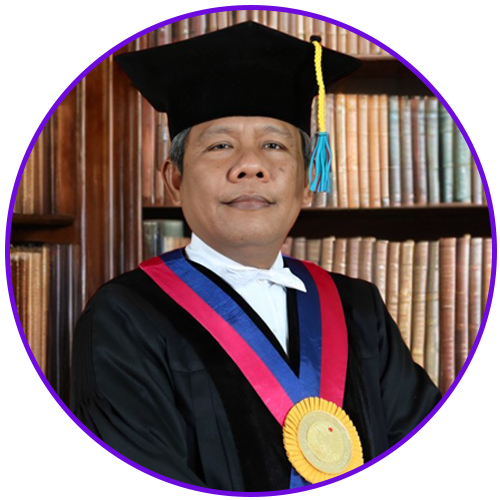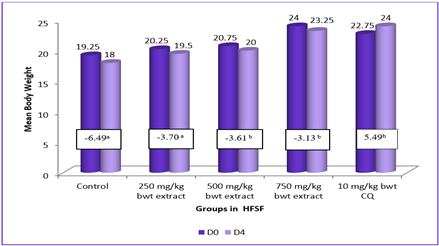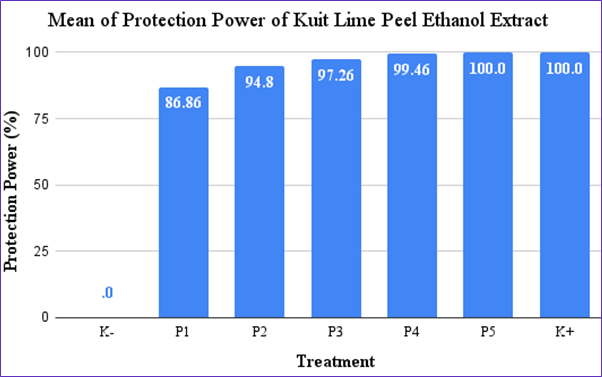Anthelmintic Activity Ethanol Extract of Ocimum sanctum Linn. Leaves Against Ascaridia galli In Vitro
Downloads
The aims of this research are to determine concentration, exposure time, interaction between concentration and exposure time of ethanol extract of Ocimum sanctum Linn. Leaves to cause death toward Ascaridia galli in vitro, and the value of LC50 and LC90 ethanol extract of Ocimum sanctum Linn. Leaves. Research design that has been used in the research was completely randomized design. This research used 200 samples of Ascaridia galli with length 7-11 cm without differentiating their sex. The concentration ethanol extract of Ocimum sanctum Linn. leaves were 1.25%, 2.5%, 5%, 10%. The control was using CMC-Na 0.5%. Each treatment then being replicated four times. The observation and recording of dead worm were done at 0, 3, 6, 12 and 24 hours. Ascaridia galli were declared dead if there was no movement while disturbed by anatomy tweezers and dipped in slightly warm water (50ºC). The obtained data was analyzed using Anova Factorial and continued with Duncan Multiple Range Test by SPSS for Windows 22. The result were 10% concentration and exposure time for 24 hours caused the most mortality toward Ascaridia galli. Interaction between concentration and exposure time resulted 10% concentration ethanol extract of Ocimum sanctum Linn. leaves in 24 hours caused the most mortality towards Ascaridia galli. Probit analysis was used to calculate the LC50 and LC90 of Ocimum sanctum Linn. leaves. The results were LC50 ethanol extract of Ocimum sanctum Linn. leaves at 6 hours was 14.8%, at 12 hours was 4.8% and at 24 hours was 3.0% and the LC90 at 24 hours was 9.1%.
Agarwal, C., N. L. Sharma and S.S. Gaurav. 2012. An Analysis of Basil (Ocimum sp.) to Study The Morphological Variability. Indian Journal of Fundamental and Applied Life Science, 3 (3), 521-525.
Ali, S.A., G.E. Mohammed and A.A. Gamel. 2012. In vitro Adulticidal Efficacy of Albendazole, Capparis decidua Stems and Moringa oleifera Leaves against Fasciola gigantica. Sudan University of Science and Technology Journal of Science and Tech¬nology, 13 (2), 59-67.
Andrew, R.W., C. Fryganas, A. Ramsay, Irene Mueller-Harvey, and M.T.Stig. 2014. Direct Anthelmintic Effects of Condensed Tannins from Diverse Plant Soures against Ascaris suum. PLoS One, 9 (5).
Athanasiadou, S., I. Kyriazakis, F. Jackson and R. L. Coop. 2001. Direct Anthelmintic Effects of Condensed Tannins towards Different Gastrointestinal Nematodes of Sheep: In vitro and In vivo Studies. Veterinary Parasitology, 99 (3), 205–219.
Buchineni, M., R.M. Pathapati, and J. Kandati. 2015. Anthelmintic Activity of Tulsi Leaves (Ocimum sanctum Linn.) An In vitro Comparative Study. Saudi J. of Med and Pharm. Sci, 2, 47–49.
Chandrasekaran, C.V., H.S. Srikanth, M.S. Anand, J.J. Allan, M.M. Viji and A. Amit. 2013. Evaluation of the Mutagenic Potential and Acute Oral Toxicity of Standardized Extract of Ocimum sanctum (OciBestâ„¢). Human and Exp. Toxicology, 32: 992-1004.
Chang, A.C.G. and M.J.C. Flores. 2015. Morpho¬logy and Viability of Adult Fasciola gigantica (Giant Liver Flukes) from Philippine Carabaos (Bubalus bubalis) upon in vitro Exposure to Lead. Asian Pacific J. of Trop Biomed, 5 (6), 493-496.
Chitwood, D. J. 2002. Phytochemical Based Strategies For Nematode Control1. Annual Review of Phytopathology, 40 (1), 221–249.
Ekeanyanwu, R. C and O. F. Etienajirhevwe. 2012. In vitro Anthelmintic Potentials of Xylopia aethiopica and Monodora myristica from Nigeria. African Journal of Biochemistry Research, 6 (9), 115–120.
Goswami, S., K. N. Mishra, A. Mishra, A.P. Singh, P. Singh, P. Singh. 2016. Comparative Assessment of In vitro Anthelmintic Studies of Some Plants From Indian Origin. Journal of Pharmacy Research, 10 (7), 514-518.
Hendrawati, A.R.E. 2009. Uji Toksisitas Akut Ekstak Etanol Daun Kemangi (Ocimum sanctum Linn.) Terhadap Larva Artemia salina Leach dengan Metode Brine Shrimp Lethality Test (BST), 1–35.
Hostettmann, K., and A. Marston. 2005. Saponins. Cambridge University Press, Medical, 564.
Hussain, A., D. O. F. Philosophy, F. Science. 2008. Evaluation of Anthelmintic Activity of Some Ethnobotanicals. Department of Parasito¬logy, Faculty of Veterinary Science, Univer¬sity of Agriculture, Faisalabad, Pakistan.
Iglesias, L., V. Adela., and F. Javier. 1997. Some Factors which Influence The In vitro Maintenance of Anisakis simplex (Nema-toda). Departemento de Parasitologia, Facultad de Farmacia, Universidad de Gran-ada, Granada, Spain. Folia Parasito¬logica 44, 297 – 301.
Joint FAO/WHO Expert Committee on Food Additives (JECFA). 2001. Sodium Carboxy-methyl Cellulose. 15 November 2017.
Joseph, B., and V. Nair. (2013). Ethanopharmaco-logical and phytochemical aspects of Oci¬mum sanctum Linn. The Elixir of Life. Bri¬tish Journal of Pharmaceutical Research, 3 (2)¬, 273–292.
Joshi, K. C., D. Nanda, P. Nainwal, and P. Saini. 2013. In vitro Anthelmintic Activity of Ocimum sanctum, International Journal of Pharma Sciences, 3 (4), 287–288.
Kamel, S., N. Ali., K. Jahangir, S. M. Shah and A. A. El-Gendy. 2008. Pharmaceutical Significance of Cellulose: A Review. Express Polymer Letters, 2 (11), 758-778.
Karumari, R. J., K. Vijayalakshmi and S. E. Balasubramanian. 2014. Preliminary Phyto-che¬mical Analysis and Anthelmintic Activity of Aqueous Extract of Ocimum sanctum (Linn.eaus, 1767) Leaves (Green and Black) Against Cotylophoron cotylo¬phorum (Fisch-oeder, 1901). International Journal of Pharma and Bio Sciences, 5 (2), 580-587.
Katoch R., A. Yadav, R. Godara, J. K. Khajuria, S. Borkataki and S. S. Sodhi. 2012. Prevalence and Impact of Gastrointestinal Helminthes on Body Weight Gain in Backyard Chickens in Subtropical and Humid Zone of Jammu, India.
Khaled, B. and B. Abdelbaki. 2012. Rheological and Electrokinetic Properties of Carboxy-methylcellulose-water Dispersion in the Presence of Salts. International Journal of Physical Science, 7 (11), 1790-1798.
Koche, D., S. Imran, R. Shirsat, and D. Bhadange. 2011. Comparative Phytochemical and Nutritional Studies of Leaves and Stem of Three Lamiaceae Members. Research Journal of Pharmaceutical, Biological and Chemical Sciences, 2 (3), 1-4.
Kombe, L., P. A. Abdu, J. O. Ajanusi. S. J. Oniye, and A.U. Ezealor. 2012. Effects of Ascaridia galli Infection on Body Weight and Blood Parameters of Experimentally Infected Domestic Pigeons (Columba livia domestica) in Zaria, Nigeria. Revista Cientifica UDO 960 Agricola, 12 (4), 960-964.
Kumar, N., A. Yadav, N. Aggarwal, and R. Gupta. (2016). Protective Effect of Ocimum sanctum Plant Extract Against DNA Damage Induced by Malathion in Cultured Human Peripheral Blood Lymphocytes. International Journal of Current Microbiology and Applied Sciences, 5 (5), 840–847.
Kusriningrum, R.S. 2008. Perancangan Perco¬baan. Airlangga University Press, Surabaya.
Luka S. A., I. S. Ndams. 2007. Gastrointestinal Parasites of Domestic Chicken Gallus-gallus domesticus Linnaeus 1758 in Samaru, Zaria Nigeria.Science World Journal, 2 (1), 27-29.
Matsuda. M., N. Suzuki, and S. Taniguchi. 2006. Small Molecule Inhibitors of α-Synuclein Filament Assembly. Biochemistry, 45 (19), 6085-6094.
Meyer, B.N., N.R. Ferrigni, J.E. Putnam, L.B. Jacobsen, D. E. Nicholas, and J.L. Mc Laughlin. 1982. Brine Shrimp: A Convenient General Bioassay for Active Plant Consti-tuents. Planta Med May, 45 (5), 31-34.
- Every manuscript submitted to must observe the policy and terms set by the Journal of Parasite Science
- Publication rights to manuscript content published by the Journal of Parasite Science is owned by the Journal of Parasite Science with the consent and approval of the author(s) concerned
- Authors and other parties are bound to the Creative Commons Attribution-NonCommercial-ShareAlike 4.0 International License for the published articles, legal formal aspect of journal publication accessibility refers to Creative Commons Attribution-NonCommercial-ShareAlike 4.0 International License (CC BY-NC-SA)
- By submitting the manuscript, the author agrees to the requirement that the copyright of the submitted article will be transferred to Journal of Parasite Science as the publisher of the journal. The intended copyright includes the right to publish articles in various forms (including reprints). journal of parasite science retains the publishing rights to published articles.

































